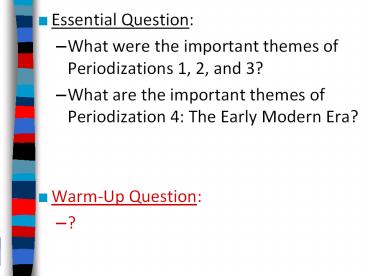Essential Question: - PowerPoint PPT Presentation
1 / 17
Title:
Essential Question:
Description:
Essential Question: What were the important themes of Periodizations 1, 2, and 3? What are the important themes of Periodization 4: The Early Modern Era? – PowerPoint PPT presentation
Number of Views:118
Avg rating:3.0/5.0
Title: Essential Question:
1
- Essential Question
- What were the important themes of Periodizations
1, 2, and 3? - What are the important themes of Periodization 4
The Early Modern Era? - Warm-Up Question
- ?
2
Periodization Overview
- A periodization is a major era in history. The
year 1450 corresponds to the transition between
Periodizations 3 and 4. - Examine the timeline provided answer the
questions in each box - When finished, be prepared to share your answers
3
Periodization 1 FoundationsNeolithic
Revolution River Valley Civilizations
- River valleys were good areas for farming
- (a) Egypt, (b) Mesopotamia, (c) India, (d)
China
4
Classical Civilizations
- These civilizations created cultural achievements
that are still used today - (a) Greece, (b) Rome, (c) Persia, (d) Gupta
India, (e) Han China, (f) Alexander the Great
5
Periodization 2 Post-Classical Era
- (a) Islamic Empire, (b) Mali, (c) Byzantine
Empire, (d) Mongols, (e) Mayans, (f) China,
(g) Medieval Europe
6
Pd 3 Transition to the Modern Era (1450-1750)
- Trade, cities, banking, Greco-Roman culture
(Classicism), art, literacy, questioning - (a) Leonardo da Vinci, (b) Medici, (c)
Machiavelli, (d) Martin Luther, (e) John
Calvin, (f) Johannes Gutenberg
7
Pd 3 Transition to the Modern Era (1450-1750)
- (a) Prince Henry, (b) Vasco daGama, (c) Magellan,
(d) Mercantilism, (e) Columbian Exchange, (f)
Louis XIV, (g) Peter the Great, (h) Copernicus
8
Periodization Overview Matching Read each
periodization description and match it to the
correct periodization title
- Periodization 1 Foundations (5,000 B.C. 600
A.D.) - Periodization 2 Post-Classical Era (600 1450)
- Periodization 3 Transition to the Modern Era
(1450-1750)
9
Periodization 1 Foundations
B
- A time after the discovery of farming when
civilizations began for form along the fertile
soils of river valleys. Over time, many river
valley societies developed into advanced
civilizations which then led to the rise of large
empires. Finally, some societies developed such
important cultural achievements that they
became classical civilizations because their
achievements influenced other societies and the
modern world.
10
Periodization 2 Post-Classical Era
C
- A time when numerous societies became more
connected to each other due to an increase in
trade. New trade routes led to cultural
diffusion, spread technology, and spread major
world religions such as Islam, Buddhism, and
Christianity (Catholic and Eastern Orthodox).
11
Periodization 3 Transition to the Modern World
(1450-1750)
A
- A time when Western Europe emerged from the
Middle Ages and experienced a rebirth in trade,
cities, learning, art. During this era,
Europeans questioned many existing preconceptions
such as ideas about religion, science, and
government. This era marked the rise of the West,
a time when Europeans began to spread their
influence to parts of America and Asia
12
Periodization 4 Predictions
- What will happen in world history during
Periodization 4 (17501914)? - Examine the next four images make a prediction
about what will happen in Periodization 4 - Be prepared to discuss your answers
13
Gunpowder technology led to powerful Islamic
Empires in Asia
1
14
2
The Enlightenment inspired political revolutions
in the Americas in France
15
Western Europe and the United States experienced
an industrial revolution
3
16
4
Industrial nations used imperialism to create
colonies dominate Africa Asia
17
Definition of Periodization 4 The Early Modern
Era (1750-1914)
- A time when revolutionary ideas about government
led to political revolutions democracies in
America Europe. During this era, gunpowder
industrial technologies made Western Europe the
dominant force in the world weakened formerly
powerful empires in Asia. Industrial nations
used imperialism to create colonies in Africa
Asia































